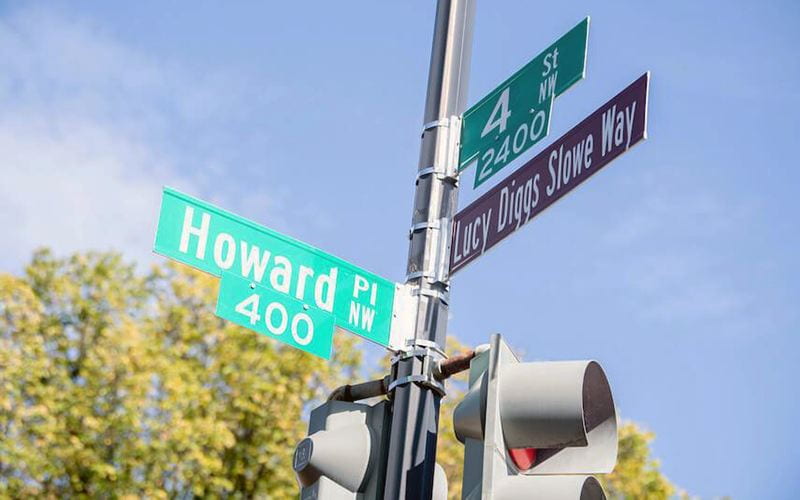Lucy Diggs Slowe and the ‘New Howard Woman’
By Blog Editor, IOE Digital, on 3 October 2023

Street sign of Lucy Diggs Slowe Way, Howard University. Credit: Justin D. Knight/Howard University.
3 October 2023
By Sandra Leaton Gray and David Scott
On 22 October 2021, Howard University honoured the American educator Lucy Diggs Slowe by naming a street after her at 2455 4th St NW, Washington DC. The designation ceremony was led by Mayor Muriel Bowser, a Howard alumna herself. Phylicia Rashad, Dean of the Chadwick A. Boseman College of Fine Arts, asked the question: “What was that impetus, what was that spirit inside that young woman? This faith and confidence and belief in herself? … What I am really excited about is discovering that same spirit within our young women on this campus today. And bringing them to that realisation within themselves of who they are in spirit. Confident. Aware. Capable. Strong. Intelligent. Prepared to inspire the next generation, the next generation, the next generation. Because this is what we do, this is how we are, and this is how we stay.”
Lucy Diggs Slowe (1885-1937) is included in our book of women curriculum theorists, published earlier this year. She was born as one of seven children in Virginia, 20 years after the end of slavery. Lucy Diggs Slowe was therefore a member of a new generation, experiencing freedom and education for the first time. Subsequently orphaned, she nevertheless excelled at school and in 1904 won a scholarship to attend Howard University in Washington DC, the top Black university in the country. This was an astonishing achievement. At the time, less than 1% of young Black people and 5% of young White people in the US were eligible to attend university.
By 1908, Lucy Diggs Slowe had graduated as a class teacher, following a relatively conventional path for educated Black women in the early part of the 20th century, as career opportunities were relatively limited. She was tireless. She studied for a Master’s degree at Columbia University, graduating in 1915, created the first junior high school for Black students in the District of Columbia, and, while its principal, also created the district’s first in-service training programme for junior high school teachers.
It was at Howard University, however, where Lucy Diggs Slowe really made her mark. In 1922 she was appointed as the first Dean of Women, creating the women’s campus, three new women’s residences, and generally professionalising the role of Dean in the US university sector. The sheer number of foundations and organisations she led, or was otherwise involved with, was remarkable. By 1937 she had died in post, from kidney disease.
Her frequent battles with university president Mordecai Wyatt Johnson cannot have improved her health. He paid her less than the male deans, cut budgets for the women’s programmes, removed her from conferences of academic deans, refused to attend events organised by her, and tried to reduce her role to that of a kind of matron living on campus. Matters came to a head in 1927 when Johnson openly attacked her authority, sabotaging her relationship with the male deans, after she reported that Professor Clarence Mills was sexually harassing young women students in class. (Clarence Mills, on the other hand, was allowed to finish the academic year, with a lengthy paid leave of absence to complete his doctorate, before finally leaving the university.)
Despite Johnson’s considerable efforts to undermine and belittle her, Lucy Diggs Slowe leaves the legacy of the ‘New Howard Woman’. This was a form of human flourishing, part of a broader movement built on the idea of universal suffrage, and grounded in the democratic promise of equal education for Black students. She argued this should be facilitated through leadership training, intellectual activism and volunteer work.
These were highly controversial ideas at the time. Black women were frequently subject to oppressive male conservative values, inhibiting their opportunities for self-definition. Indeed, to many at the university, and beyond, Black women were seen as mere adjuncts to Black men.
Nevertheless, Lucy Diggs Slowe persisted. It is possible to get an idea of her character from a letter she sent to the men of Howard University, as she founded the Annual Howard Women’s Dinner in 1922, as an act of performative resistance: “We are indeed sorry you must miss so much fun, but you may retaliate on us whenever you desire by having a men’s dinner. If you had thought of this first, you could have had the laugh on us, but your thoughts are evidently concerned with more weighty matter than eating … we are going to invite you to stand in the balcony of the dining hall to look down on us. From this, your point on vantage, you can force us women to do the usual thing; look up to you.”
The dinner, and praxis of participatory democracy, continued annually for 15 years until her death.
A postscript: it is possible to visit the Slowe-Burrill House, which Lucy Diggs Slowe shared with her partner Mary Powell Burrill (1881-1946), and where they hosted innumerable salons and intellectual gatherings. It is located at 1256 Kearny Street in Washington DC.
Read more about Lucy Diggs Slowe’s life and achievements in Leaton Gray, S. and Scott, D. (2023) Women Curriculum Theorists: Power, Knowledge and Subjectivity (London, Routledge).
 Close
Close



